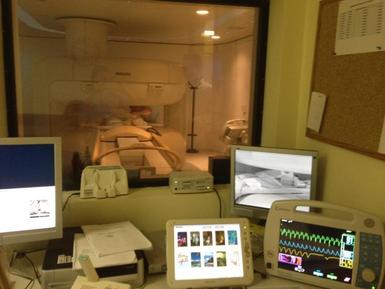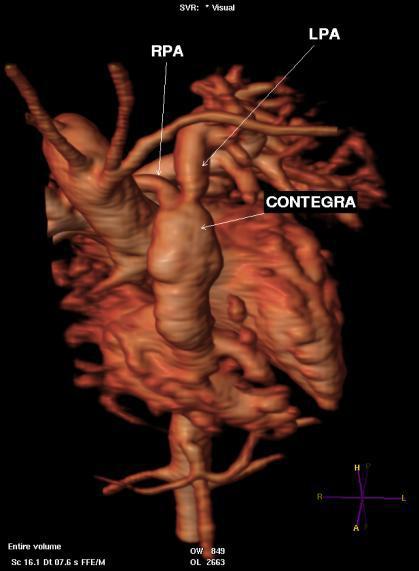Cardiac magnetic resonance imaging (cardiac MRI)

MRI imaging in neonates and children with general anaesthesia
Cardiac MRI offers high resolution imaging of the cardiac anatomy, as well as accurate assessment of cardiac function and physiology, which is of particular importance in patients with congenital heart disease. MRI does not involve any ionizing radiation, hence its is much preferred in young patients, comparing to CT.
MITERA Hospital are equipped with an Open Magnetic Field system, with easier access to small intubated patients.
Why is general anesthesia required for young children and neonates who undergo a cardiac MRI examination?
General anesthesia for cardiac MRI is performed in nearly all specialist Congenital Heart Disease Centers internationally. This is necessary because at the time the images are taken, the child’s thorax must be completely still, with no breathing motion, so that images are free of technical artifacts. This is achieved by breath holds of about 20-30 seconds. Older children can manage that, but smaller children of <6 years of age cannot hold their breath for such period, hence the Anesthesiologist must perform the breath hold through the ventilator. The procedure is better controlled and safer when general anesthesia is administered in sick patients; of paramount importance is the Anesthesiologist’s and Cardiologist’s continuous presence in the room, continuous monitoring of vital functions with special monitors, compatible with the magnetic environment, as well as emergency CPR equipment in the area of magnetic tomography. Deep sedation is not used when complex cases are studied, as children can still breathe during image acquisition and artifacts can still be present. Please note that in any case the anesthetic drugs that are used to achieve seep sedation are equivalent or the same with those of general anesthesia.
Is cardiac MRI safe for my child?
In neonates and children with severe heart disease, the examination is always performed in the presence of a specialist Paediatric Cardiologist and with prior notification of the paediatric intensive care unit, in case of the potential need to admit the child to the intensive pediatric unit after the scan.
If your child has a pacemaker or other metallic devices in the chest or if he wears braces, then the magnetic field may not be safe. Please contact your doctor or the MRI unit for further details.
What will happen if my child is unwell?
A typical cold does not usually postpone the examination as it has been approved internationally that anesthesia does not aggravate the condition of the child, instead cancellation of the examination may cause inconvenience and cost for everyone involved, without guaranteeing that at the next appointment the child may not have a cold. In the case of an intercurrent illness, the parent or pediatrician of the child should notify the Paediatric Cardiologist or Anesthetist involved in the child’s examination before admission to the hospital.
Where will I go when I get to the hospital?
In order to check if a child with congenital heart disease is suitable for general anesthesia, the child must first be checked by a paediatric cardiologist. The doctor will check his clinical condition as well as the cardiac anatomy and physiology with an echocardiogram. Occasionally a chest X-Ray may be required prior to the MRI scan.
Can my child eat before the exam?
Current guidelines for fasting before anesthesia or sedation recommend eating a light meal or milk up to six hours before the examination and clear fluids up to two hours before ΜRI. In case of breastfeeding, this is allowed about four hours before. Clear liquids include water, chamomile, tea, coffee (for adults) and orange juice or drained fresh juice without the “chunks” of the fruit. For example: a carbon-free orange juice is allowed up to 2 hours before the test. In general, it is encouraged to drink fluids up to two hours before the anesthesia. Especially in children with cyanotic heart disease, who usually have high hematocrit, pre-anaesthesia hydration is critical and may require intravenous administration of iv fluids. Please note that general anesthesia usually begins about half an hour before the MRI appointment.
If your child takes any medication, you will give them as usual. You should not give medication for 3 hours prior to anesthesia.

Who will be with my child during the examination?
You can escort your child to the department until he/she is handed over to the Anesthetist. The Cardiac Anesthetist, Paediatric Cardiologist and Specialist Radiologist, as well as members of the nursing staff will be with your child during the examination. Doctors will show you 3D images of your child’s heart at the end of the examination and will discuss with you some preliminary results.
How long does the exam last?
The examination lasts between 45 minutes to 1.5 hour.
What will happen next?
When the MRI is finished, your child will be transferred to the ward. He/she will be placed on a heart monitor until they are fully awake. After the child has fully recovered and is able to eat and drink you will be discharged; that takes place usually a few hours later.
Doctors will review the raw images and will do the post-processing analysis of the anatomical data and cardiac physiology and will contact you or your doctor with the results.

